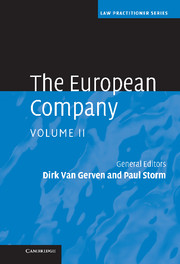3 - Czech Republic
from Part II - Application in each Member State
Published online by Cambridge University Press: 06 July 2010
Summary
Introduction
1. The Regulation and the Directive have been implemented into Czech law by the Act on the European Company No. 627/2004 Coll., effective 14 December 2004 (the ‘SE Act’), and by Regulation No. 293/2005 Coll., effective 21 July 2005, issued by the Ministry of Justice, on documents that must be presented to a notary public for the issuance of a certificate in the event of the relocation of the registered office of a European company or the establishment of a European company by merger.
Formation
General remarks
Founding parties
2. An SE whose registered office will be located in the Czech Republic may be founded by a company whose head office is not located in a Member State, provided it is founded in accordance with the laws of a Member State and has its registered office in that state as well as a permanent and effective link with the economy of a Member State (Art. 2(5) Reg.).
Name
3. An SE shall be referred to as an evropská spole{č}nost in Czech.
Registered office and transfer
Registered office
4. Pursuant to the Regulation, the registered office of an SE should be located in the same Member State as its head office (Art. 7 Reg.). Under Czech law, if an SE has its registered office in the Czech Republic, its head office should be at the same location as its registered office.
- Type
- Chapter
- Information
- The European Company , pp. 85 - 113Publisher: Cambridge University PressPrint publication year: 2008

